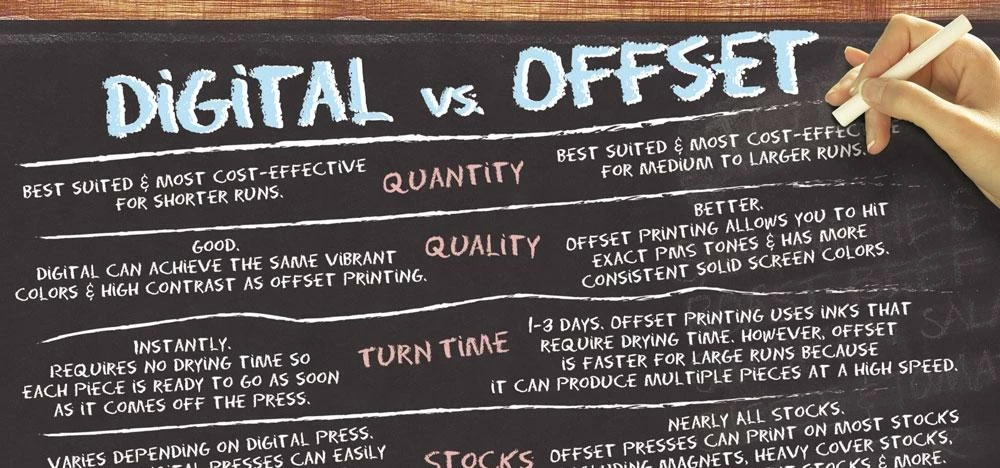
Partner Article
Digital vs. Offset Printing
Advantages of Each and How to decide which Right is for Your Project.
The growth of digital printingtechnology has brought technical advancements, more options, and exciting new features to today’s commercial printing. It’s also brought some confusion. An understanding of the advantages and disadvantages of digital printing and how those compare to traditional offset is critical in making the right choice.
Offset printing is the most common high volume commercial printing technology. In offset printing, the desired print image is burned onto a plate and is then transferred (or offset) from the plate to a rubber blanket, and then to the printing surface (paper). This process is based on the repulsion of oil and water. The image to be printed gets ink from ink rollers, while the non-printing area attracts a film of water, keeping the non-printing areas ink-free.
Advantages of Digital • Shorter turnaround. • Every print is the same. More accurate counts, less waste and fewer variations, due to not having to balance ink and water during press run. • Cheaper low volume printing. While the unit cost of each piece may be higher than with offset printing, when setup costs are included digital printing provides lower per unit costs for very small print runs. • Variable Data Printing is a form of customizable digital printing. Using information from a database or external file, text and graphics can be changed on each piece without stopping or slowing down the press. For example, personalized letters can be printed with a different name and address on each letter.
Advantages of Offset • High image quality. • Works on a wider range of paper substrates. • The unit cost goes down as the quantity goes up. • Quality and cost-effectiveness in high volume jobs. While today’s digital presses are close to the cost/benefit ratio of offset for high quality work, they are not yet able to compete with the volume an offset press can produce. • Our offset press uses a computer-to-plate systems as opposed to the older computer-to-film work flows, further increasing quality.
Use this checklist to help decide:
• Quantity. Offset printing has a front-end cost load. Short runs may have a high unit cost. But as quantities increase, the unit cost goes down with offset printing. Very short runs can be much more cost effective with digital printing; while larger quantities are likely to have a lower unit cost with offset printing. • Printing medium. Do you need or want a special paper, finish or unusual printing surface, or unique size? The options are increasing continually for digital, but offset printing still offers the most flexibility. • Color. Digital presses use four-color process printing. If you need only black ink or one or two ink colors, offset printing may offer a more cost-effective solution. If you need four-color printing, digital may offer advantages in lower up-front costs. • More on color. If you’re planning to print using the Pan tone Matching System, offset printing will give you the best match, since it uses actual Pan tone ink. Digital printing simulates the color using a four-color matching process, so some digital printers may offer less accurate color matching on projects. • Turnaround. If you need it fast, digital usually offers quicker delivery. • Proofing. Digital offers accurate proofs since you see an actual sample of the printed piece. Accurate color proofing for offset printing can be expensive. • Customization. Without question, digital printing offers the most affordable way to customize marketing materials, direct mail pieces, letters, etc.
This was posted in Bdaily's Members' News section by Advance litho ltd .








 How to make your growth strategy deliver in 2026
How to make your growth strategy deliver in 2026
 Powering a new wave of regional screen indies
Powering a new wave of regional screen indies
 A new year and a new outlook for property scene
A new year and a new outlook for property scene
 Zero per cent - but maximum brand exposure
Zero per cent - but maximum brand exposure
 We don’t talk about money stress enough
We don’t talk about money stress enough
 A year of resilience, growth and collaboration
A year of resilience, growth and collaboration
 Apprenticeships: Lower standards risk safety
Apprenticeships: Lower standards risk safety
 Keeping it reel: Creating video in an authenticity era
Keeping it reel: Creating video in an authenticity era
 Budget: Creating a more vibrant market economy
Budget: Creating a more vibrant market economy
 Celebrating excellence and community support
Celebrating excellence and community support
 The value of nurturing homegrown innovation
The value of nurturing homegrown innovation
 A dynamic, fair and innovative economy
A dynamic, fair and innovative economy